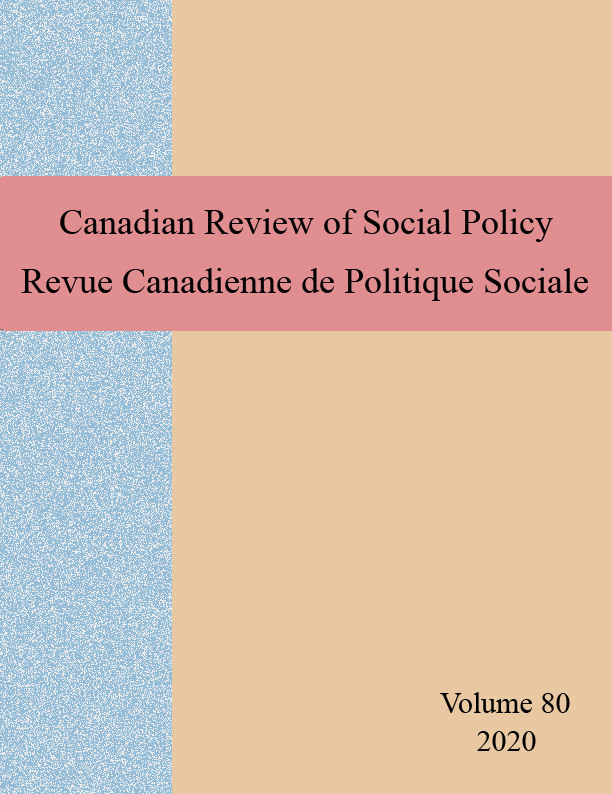La gouvernance collaborative comme un prisme conceptuel pour comprendre le programme Ville-amie des aînés au Québec : Étude de quatre cas contrastés
Keywords:
Ville-amie des aînés, Gouvernance collaborative, Étude de cas, VieillissementAbstract
La population canadienne est vieillissante et les politiciens, tant sur les scènes fédérale et provinciale que dans les municipalités, cherchent à relever les enjeux qui y sont associés. Depuis 2007, il est apparu dans le paysage des politiques sociales une nouvelle initiative promue par l’Organisation mondiale de la santé : la Ville-amie des aînés. Au Canada, il est possible de retrouver des programmes Ville-amie des aînés dans toutes les provinces. Le Québec compte plus de 900 initiatives ; cela signifie que 90 % des habitants du Québec vivent dans une municipalité qui a entrepris un processus pour devenir « amis des aînés ». Nous examinerons ce programme au Québec à partir des résultats provenant d’une étude qui a été financée par les Instituts de recherche en santé du Canada. À partir d’un devis mixte autour de quatre études de cas contrastés de la région de la Montérégie au Québec, notre article propose d’illustrer le processus de collaboration au sein des Villes-amies des aînés en prenant assise sur le modèle conceptuel d’Ansell et Gash (2008) concernant la gouvernance collaborative. Les résultats de l’étude montrent les différentes catégories conceptuelles du modèle qui s’appliquent aux Villes-amies des aînés : les conditions initiales, le leadership, les règles et les protocoles institués, de même que le processus circulaire de la gouvernance collaborative. Bien que la gouvernance collaborative au sein des Villes-amies des aînés présente plusieurs enjeux, elle devient aussi, à travers le comité de pilotage de ce programme, une opportunité pour les acteurs locaux et régionaux d’agir sur le vieillissement de la population.
Abstract
Canada’s population is aging and politicians at the federal, provincial and municipal levels are trying to address the associated issues. Since 2007, a new initiative promoted by the World Health Organization has entered the social policy landscape: the Age-friendly City. In Canada, Age-friendly City programs can be found in all the provinces. Quebec has more than 900 initiatives, and 90% of Quebec residents live in a municipality that has begun the process of becoming “age-friendly”. This paper will examine this program in Quebec using the results of a study funded by the Canadian Institutes of Health Research. Based on a mixed method of four contrasting case studies in Quebec’s Montérégie region, our paper intends to illustrate the main stages (the consultation, action plan and implementation) of the Age-friendly city program in Quebec using Ansell and Gash’s (2008) conceptual model of collaborative governance. The results show how the different conceptual categories apply to Age-friendly Cities: starting conditions, facilitative leadership, institutional design, and cyclical collaborative process. Although several challenges can be associated with collaborative governance in Age-friendly cities, it can also become, through the steering committee for this program, an opportunity for the local and regional actors to address the aging of the population.
Keywords: Age-friendly Cities; collaborative governance; case study; aging
Downloads
Published
How to Cite
Issue
Section
License
1-The author guarantees that the manuscript is an original work not published elsewhere in print or electronically in whole or in part, except in abstract form, that the author has the full power to make this contribution, and that the manuscript contains no matter libelous or otherwise unlawful or which invades the right of privacy or which infringes any proprietary right.
2-The author guarantees that the manuscript has not been previously published in print or electronically and that if the manuscript contains any tables, figures or images fully reproduced or closely adapted from previously published material, the author must obtain the necessary permission from the author/publisher holding the original copyright prior to publication in CRSP. The author may be required to produce evidence of permission granted to CRSP’s editors.
3-As a condition of publication in CRSP, the author assigns all copyright to CRSP, including but not limited to the right to publish, republish, and otherwise distribute this manuscript in print, electronic, or other formats. As CRSP is a non-profit interdisciplinary scholarly journal, the author will receive no royalty or other monetary compensation for the assignment set forth in this agreement.
For the purpose of full disclosure, CRSP will not normally use the content provided by the author in a commercial venture, but for the purpose of disseminating the author’s content to as many readers as possible. For distribution, third parties engaging in commercial activities may be contracted to distribute the content globally, and such parties may make a profit out of the author’s content in their normal course of business. CRSP will not pay the author or reimburse the author in any form based on such commercial activities because the conduct of such commercial activities is outside the control of CRSP.
Any future reference to or use of this published material by the authors must acknowledge CRSP as the original place of publication.
PERMISSION REQUEST/ARCHIVING
Permission is given to author(s) receiving funding via Tri-Council Agencies, the Canadian Institutes of Health Research (CIHR), the Natural Sciences and Engineering Research Council of Canada (NSERC) and the Social Sciences and Humanities Research Council (SSHRC), to make their publications freely available in an Open Access repository within the stated deadline by the Tri-Council Agencies (12 months following publication). Archiving of publication must be a manuscript copy bearing none of the CRSP headers, footers or any other distinguishing marks. No links to the article on the CRSP website is permitted.
Permission requests from third parties to reproduce articles in part or full in academic/educational publications can be directed to the managing editor of CRSP, and will not be unreasonably denied.

